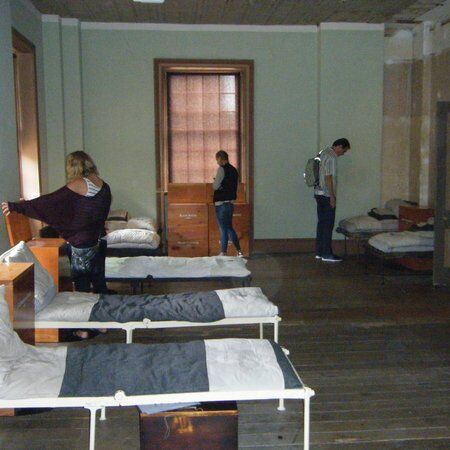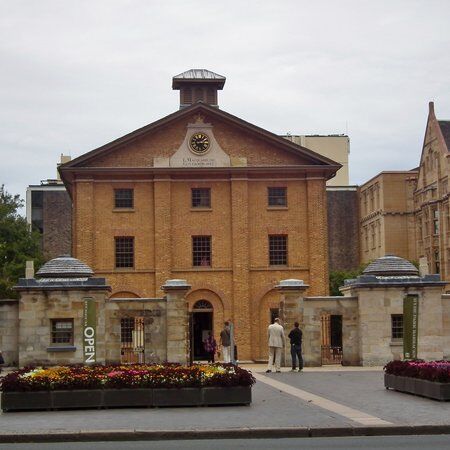
Discover Hyde Park Barracks
A UNESCO World Heritage site located at the end of Sydney’s Macquarie Street, Hyde Park Barracks stands in recognition of colonial Australia. Originally constructed between 1817 and 1819, the barracks were designed by convict architect Francis Greenway to house male convicts. Before its establishment, convicts were responsible for finding their own lodgings, but the creation of the barracks allowed the government to exercise more effective control over convicts in the colony.
Throughout its history, Hyde Park Barracks has had many uses, evolving with the needs of the colony. It has functioned as a women’s immigration depot and asylum, law courts, government offices, and today, a museum managed by Sydney Living Museums. The museum has over 4,000 original artefacts, which it uses to convey the stories of the thousands of men, women, and children who lived or were held there.

Hyde Park Barracks and the Penal Colony
Arrival and Settlement
In January 1788, the First Fleet of 11 British ships arrived at Port Jackson, which was renamed Sydney Cove, or Warrane by the Gadigal people. The fleet carried over 1000 people, including more than 700 convicts. This was the establishment of the penal colony of New South Wales. The British used convict labour to build and sustain the colony, leveraging their sentences for productive purposes.
Early Conditions
Convicts in the early decades of the colony experienced relatively good conditions. They often lived with a degree of freedom, working for private masters or on government projects under a system known as 'task work'. This allowed convicts to have some free time and build new lives for themselves after completing their assigned tasks, which helped establish the local economy. However, this freedom frequently resulted in bad behaviour and crime, prompting calls for stricter control over convict living arrangements.

Opening the Hyde Park Barracks
Increased Traffic
After 1814 there was an increase in the number of convicts transported to New South Wales, with the annual intake doubling over the next five years. Between 1814 and 1820, 11,765 convicts arrived in the colony. This surge was due to the end of the Napoleonic Wars and resulting economic and social instability in Britain and it presented Governor Lachlan Macquarie with many challenges. During Macquarie’s time in office the colony’s population nearly tripled with convicts and ex-convicts making up over 73% of the population, peaking at 79.7% in 1820.
Stricter Measures
As the colony expanded, the British authorities began to impose stricter controls. On 4th June 1819, Governor Macquarie opened the Hyde Park Barracks, designed by Francis Greenway, Australia's first official government architect. The barracks could house 600 male convicts, around a third of the male convict population at the time.
Convicts at the Barracks were on increased rations but had fewer opportunities for private earnings and were required to work longer hours. The site included bakeries, kitchens, pantries, store rooms, and garden plots, and aimed to increase convict control, through more regulated work hours and living conditions.
Agricultural Focus
By the early 19th century, after John Thomas Bigge's 1822 report, British policy shifted towards sending convicts to work on remote farms rather than citywide projects. This shift facilitated colonial expansion, often at the expense of Aboriginal lands and communities, leading to increased frontier violence and resistance.

Social Changes and Decline of Transportation
Tightening Regulations
The arrival of Governor Ralph Darling, in 1825, saw further tightening of regulations on convicts. There was also a growing number of free settlers who feared convict violence, leading to the establishment of the Assignment Board and harsher punishments for disobedience.
Harsher Punishments
After 1830, Hyde Park Barracks transitioned into a place of secondary punishment and a depot for reassignment and trial. A Court of General Sessions administered punishments for convicts, including solitary confinement, working in gangs with irons, and up to 150 lashes.
End of Transportation
Criticism of the Hyde Park Barracks and deportation of convicts to New South Wales, led to its gradual abolition. The British government’s 1837 inquiry highlighted the system's inefficiencies and immoral nature, and so by 1848 the barracks ceased operation as convict accommodation.
New Roles
After its closure, the Hyde Park Barracks' role changed, it became an immigration depot and later a female asylum until 1887. It provided a reception and labour exchange for single or orphaned young women emigrating from Britain and Ireland, who were seeking employment in the colony. The building was adapted to accommodate these women in its dormitories.
From 1887 to 1975, Hyde Park Barracks hosted various NSW government departments, including the Government Printing Office, Office of the City Coroner, Vaccine Institute, and Sydney District Court.

Impact of Sending Convicts to the Colony
Harm to Aboriginal Peoples
The establishment and expansion of the penal colony had devastating effects on Aboriginal societies. The appropriation of lands, introduction of diseases, and violent confrontations resulted in significant casualties of Aboriginal peoples. Today, the Hyde Park Barracks and other colonial institutions symbolise this difficult period, reflecting both the growth of Sydney and the cost of colonial expansion.
Renovating the Hyde Park Barracks
In 1994, a project led by the award-winning architectural firm Tonkin Zulaikha Greer and conservation architects Clive Lucas Stapleton and Partners was conducted to adapt the barracks for modern use. The successful completion of this project earned the team the Australian Institute of Architects national Lachlan Macquarie Award in 1992.
In 2019, the barracks underwent an $18 million restoration to transform it into an immersive visitor experience, reopening in February 2020. Its listing as a UNESCO World Heritage Site, and its inclusion on the Australian National Heritage List and the New South Wales State Heritage Register highlights its status as a site of exceptional heritage value.

The Hyde Park Barracks: Design and Evolution
Location and Layout
The Hyde Park Barracks, located at Queen's Square on the corner of Macquarie Street and Prince Albert Road in Sydney, is surrounded by high walls on the south and west sides, with structures marking the northern and eastern boundaries. It is considered one of Greenway's best works, earning him an absolute pardon (he was a convict after all) at its opening.
The main building is a three-storey Georgian-style structure, which held the dormitory, with convicts sleeping in canvas hammocks in 12 rooms. It was surrounded by a gravel courtyard with sandstone pathways for disabled access—look out for the two weeping lillypilly trees.
Renovating the Dormitory Block
In the late 1980s, efforts were made to restore the Barracks to their appearance circa 1820. External doorways added for court access were in-filled, and new joinery was constructed for doors and windows. Evidence of the building's use as a court remains in some fireplaces and unusually placed doorways.
Internally, partitions were removed to reveal the original floor plan. One room has been fitted with hammock frames based on historical evidence of convict sleeping arrangements. Modern lighting has been installed to highlight museum displays.

Perimeter Wall and Outbuildings
The northern boundary has six structures. Key buildings include the original cell block and the Superintendent's Apartment. The northwestern corner pavilion, originally a cell block, has been adapted for use as a cafe. Visitors can explore sections of the ground floor and view archaeological features on a wooden platform.
The southern perimeter wall houses the Australian Monument to the Great Irish Famine, unveiled by Governor-General Sir William Deane in 1999. This memorial includes a plaque and a metal table with a dinner plate.
The eastern perimeter has three interconnected buildings with external stairs leading to a first-floor balcony. These buildings provide public amenities and office space for the museum.
The western section includes a central set of gates and lodges, with the northern lodge accessible to visitors.
Archaeology and Hyde Park Barracks
Archaeological investigations began during the 1980s restoration. Initially, Carol Powell initially catalogued the discovered items, but the site's significance necessitated larger-scale excavations, led by Wendy Thorp and Patricia Burritt.
Excavations revealed remarkable artefacts, particularly from underfloor spaces, including paper and fabric items from the Barracks’ time as a female Immigration Depot and Government Asylum.

Visiting Hyde Park Barracks Museum
The Museum Experience
Visitors to the Hyde Park Barracks museum can see displays of excavated artefacts, and exposed layers of the building’s fabric, whilst listening to an immersive audio tour. The audio is important as it follows in the footsteps of real people who were connected to the barracks, including male convicts, women in need, immigrants, and Aboriginal nations. The barracks also have historical and cultural exhibits, such as ‘After Dark,’ a monthly series featuring live music, performances, and engaging discussions.

Unlocking Heritage
"Particularly for the kids to wear the convict shirts, eat the gruel, sleep over with their mates in hammocks and imagine what life was like 200 years ago."
In June 2015, Mark Speakman, then the Minister for the Environment of New South Wales, announced the "Unlocking Heritage" program. This two-year initiative was designed to give children a hands-on experience of Sydney's living museums, particularly Hyde Park Barracks. With an allocation of one million dollars, the program allowed students to dress in convict clothing and sleep in the barracks' hammocks.

Interested in finding more places like this? Why not try one of our Scavenger Hunts in Sydney - work as a team to overcome cryptic riddles and allow yourselves to be swept off the beaten track on a journey to discover all the quirky bars and unusual sites Sydney has to offer.


















